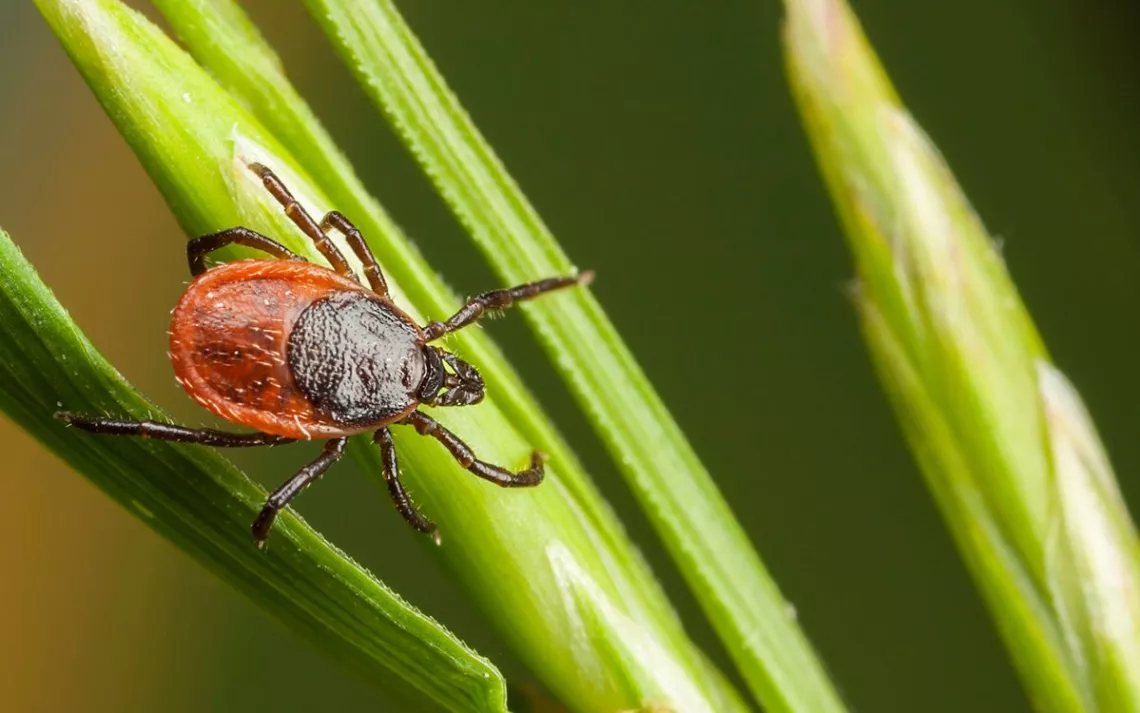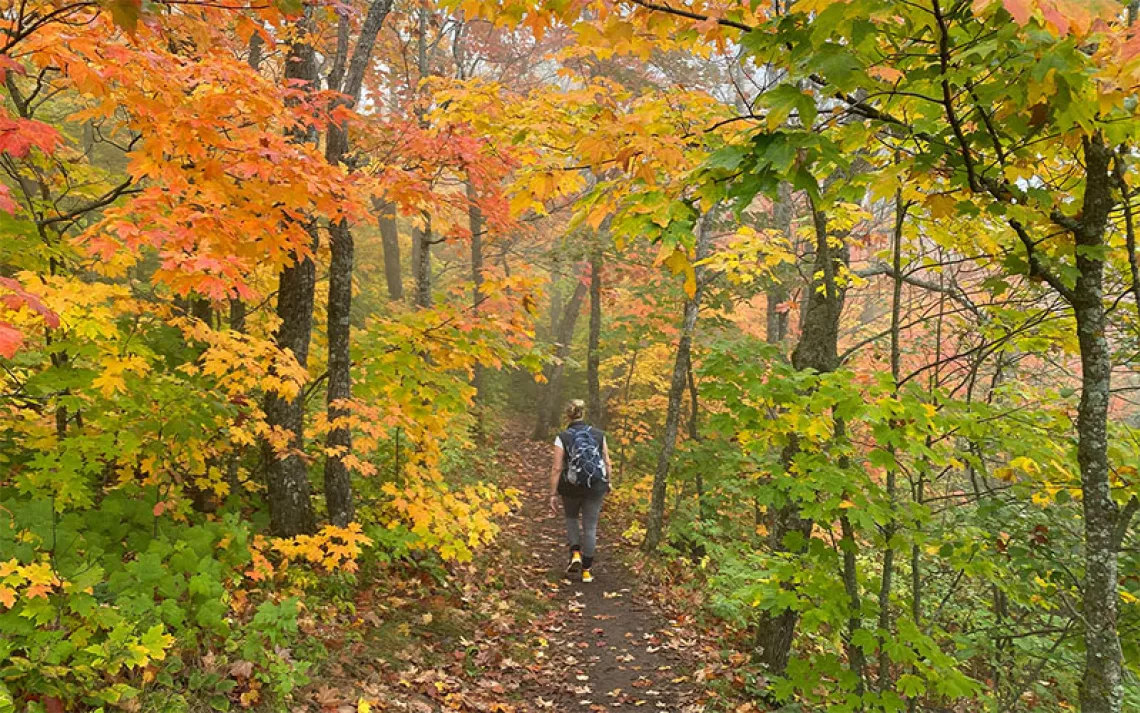An Increasingly Ticky Situation
Advice from a thru-hiker who survived Lyme disease
A decade ago, a May backpacking trip in Kentucky’s Mammoth Cave National Park changed Logan McCulloch’s life. The 51-year-old woke up and discovered 20 black-legged ticks on his lower body. McCulloch spent an hour carefully removing each (or so he thought) of the poppy-seed-size arthropods with tweezers. “I didn’t think much of it,” he admits. McCulloch’s summer was marred by nagging joint pain and fatigue, which he attributed to exercise. It wasn’t until a physiotherapist suggested the possibility of Lyme disease that he remembered the ticks. His symptoms, including temporary memory loss and confusion, only got worse before he was finally diagnosed with Lyme, becoming yet another statistic in a burgeoning health crisis.
If you enjoy spending time outdoors, you’ve likely encountered ticks. Nine native, human-biting varieties of ticks capable of transmitting illnesses to humans are found in every state except Alaska. Ticks are vectors for the transmission of bacterial and viral infections from reservoir hosts to other organisms. In the case of Lyme disease, larval black-legged ticks (also known as deer ticks, a species prevalent east of the Rockies, with a separate Pacific coast variety as well) acquire a Lyme-causing bacteria by feeding on infected white-footed mice. They can then transmit the bacteria to other mammals (a count that includes nearly 500,000 Americans annually) on their next feeding. Nymphal ticks, like the ones crawling on McCulloch, are common during spring and early summer; they’re inconspicuous and most dangerous in transmitting Lyme disease to humans. Adult ticks, more common in the late summer, are somewhat larger and easier to detect.
McCulloch’s first priority after an agonizing, year-long recovery was surprising. Rather than embracing indoor entertainment, he set out on a thru-hike of the 2,190-mile Appalachian Trail, right through the heart of some of America’s densest tick populations, in the spring of 2013. Now, with Lyme cases ballooning and more rare-yet-terrifying diseases emerging, McCulloch advocates for hikers to learn more about ticks and take a few simple actions to stay safe on the trail. He shared with me the most important things to know about tick populations as well as some best practices when recreating in tick country. Because as they say, the best way to best your enemies is to get to know them.
Tick Biology
Ticks are fascinating, even beyond the creepy-crawly and disease-transmitting aspects of their biology. All species progress through egg-, larva-, nymph-, and adult phases, playing out over two or three years, with feedings marking their transition between stages. The life cycle is interrupted by periods of dormancy in cold weather and culminates in the adult stage, with egg-laying. Ticks become active at temperatures above the freezing point. They don’t fly and cannot “drop” onto unsuspecting hikers. Rather, they feed by “questing”—holding onto a branch, leaf, or blade of grass with two legs and dangling the others, waiting to latch onto passersby. Like mosquitoes, they’re attracted to carbon dioxide. When questing yields a host, ticks then seek out warm, thin-skinned areas—a process that can take up to two hours. Ticks then burrow (black-legged ticks have barbed mouthparts) into said areas, where they lap up blood, excreting saliva that occludes pain signals and prevents clotting in the host. Some recent studies indicate that the bacteria causing Lyme disease can be transmitted from a feeding tick to an unsuspecting human in less than 24 hours.
The Risk
One way to avoid ticks is to steer clear of their habitat. There are no established populations in Alaska and across northern Canada because a cold climate interrupts ticks’ life cycle, delaying egg-laying. Alpine areas, too, are often tick-free. Performing a 2013 survey along the entire Appalachian Trail, thru-hiker and scientist Karl Ford did not detect any black-legged ticks above 2,720 feet. (A separate species, however, the Rocky Mountain wood tick, occurs at elevations of up to 10,500 feet along the Continental Divide.) Ford found fewer ticks in areas of bare ground along the AT, such as around shelters. Ticks favor moist, shaded environments like leaf litter, brush, and grass; they desiccate in direct sun. Populations vary seasonally based on temperature, precipitation, humidity, and the abundance of hosts like birds and mice. New England, New York, and Pennsylvania—along with Wisconsin, Minnesota, and Michigan—are Lyme disease hotspots. Ford, who has also thru-hiked the Pacific Coast Trail and the Continental Divide Trail, notes that tick-borne diseases occur in lower elevations and coastal ranges along the PCT. He has only encountered ticks on a 100-mile section of sagebrush in Wyoming on the CDT.
The Spread
The proliferation of black-legged ticks is yet another reminder of climate change. Hitching rides on migratory birds, ticks are expanding to new areas, and warmer temperatures allow populations to become more easily established. The number of counties with populations of black-legged ticks has more than doubled in the past two decades. At the same time, white-footed mice, which harbor the Lyme-causing bacteria, are also moving north and breeding more rapidly as the climate warms. Similarly, lone star ticks (“aggressive” blood-suckers capable of transmitting human ehrlichiosis or heartland virus and causing an allergic reaction to eating red meat) are spreading north from the Southeast. Meanwhile, habitat fragmentation and loss of biodiversity due to human development have made tick-borne pathogens more prevalent. The loss of predators like owls and hawks results in more mice and ticks in concentrated areas.

Make every day an Earth Day
Get articles like this one sent directly to your inbox.
With this action you affirm you want to receive Sierra Club communications and may vote on policy designated by the Sierra Club Board.
Living With Ticks
McCulloch now swears by tick-repellent clothing. Insect Shield apparel is infused with permethrin, a CDC-recommended chemical that repels and kills ticks. Insect Shield also allows you to mail in your own outdoor clothing for treatment, which is guaranteed effective for 70 washes. You can also use a spray-on treatment like Ben’s Clothing and Gear spray; focus on areas that are likely to brush up against leafy surfaces, including boots, socks, and pants, as well as entry points like cuffs and collars. When hiking and backpacking, McCulloch now carries a permethrin-treated sitting pad and also treats the floor of his tent (setting up on bare ground will minimize tick exposure). Pull your socks up over your pant cuffs, tuck in your shirt, and wear a permethrin-treated bandanna or cap. If you must wear shorts, a picaridin-based skin repellent like Ben’s Tick Repellent is more effective against ticks, not to mention safer and less smelly, than DEET.
Check for ticks on your clothing and exposed skin immediately after you pass through brushy and grassy areas (always do your best to stick to the center of trails). Ryan Seltzer, the natural resource and land stewardship manager for the Appalachian Trail Conservancy, suggests carrying duct tape, so as to quickly remove ticks from your clothing in the field. “You're most likely to find them on your legs,” he says. “Then they move upward towards a warm spot on the body.” Perform a more detailed tick check at the end of the day, focusing on warm, soft areas—behind your knees, groin, armpits, and scalp. Use a mirror and have a buddy inspect your back. Removing ticks as early as possible is key to staying healthy; slowly extract embedded ticks with tweezers and clean the area afterward. A bulls-eye rash around a tick bite is a tell-tale sign of Lyme disease, but it doesn’t always happen. Monitor for flu-like symptoms and muscle and joint pain; visit a doctor if you’ve been in a Lyme-prone area and suspect you’ve been bit. Early antibiotic treatment is effective in most cases.
The Vaccine Factor
Since the controversial LYMErix vaccine was discontinued in 2001, pharmaceutical companies have been working on a replacement. Perhaps the most promising is a preventative shot called Lyme PrEP, developed at the University of Massachusetts and recently approved for clinical trials. The shot, which could come to market as soon as 2023, would work to destroy Lyme bacteria in the bloodstream and would need to be readministered every year.
Meanwhile, outdoor enthusiasts like McCulloch aren’t waiting on a Lyme vaccine to keep enjoying nature. McCulloch hiked the entire Appalachian Trail in 2013 without having to remove a single tick. “Don’t be afraid from my experience,” he says. “Knowledge is power. Get out there and enjoy the trail.”
 The Magazine of The Sierra Club
The Magazine of The Sierra Club




